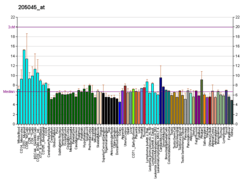AKAP10
A kinase anchor protein 10, mitochondrial is an enzyme that in humans is encoded by the AKAP10 gene.[5][6]
| AKAP10 | |||||||||||||||||||||||||
|---|---|---|---|---|---|---|---|---|---|---|---|---|---|---|---|---|---|---|---|---|---|---|---|---|---|
| |||||||||||||||||||||||||
| Identifiers | |||||||||||||||||||||||||
| Aliases | AKAP10, AKAP-10, D-AKAP-2, D-AKAP2, PRKA10, A-kinase anchoring protein 10 | ||||||||||||||||||||||||
| External IDs | OMIM: 604694 MGI: 1890218 HomoloGene: 32452 GeneCards: AKAP10 | ||||||||||||||||||||||||
| |||||||||||||||||||||||||
| |||||||||||||||||||||||||
| |||||||||||||||||||||||||
| |||||||||||||||||||||||||
| Orthologs | |||||||||||||||||||||||||
| Species | Human | Mouse | |||||||||||||||||||||||
| Entrez | |||||||||||||||||||||||||
| Ensembl | |||||||||||||||||||||||||
| UniProt | |||||||||||||||||||||||||
| RefSeq (mRNA) | |||||||||||||||||||||||||
| RefSeq (protein) | |||||||||||||||||||||||||
| Location (UCSC) | Chr 17: 19.9 – 19.98 Mb | Chr 11: 61.87 – 61.93 Mb | |||||||||||||||||||||||
| PubMed search | [3] | [4] | |||||||||||||||||||||||
| Wikidata | |||||||||||||||||||||||||
| |||||||||||||||||||||||||
Function
The A-kinase anchor proteins (AKAPs) are a group of structurally diverse proteins, which have the common function of binding to the regulatory subunit of protein kinase A (PKA) and confining the holoenzyme to discrete locations within the cell. This gene encodes a member of the AKAP family. The encoded protein interacts with both the type I and type II regulatory subunits of PKA; therefore, it is a dual-specific AKAP. This protein is highly enriched in mitochondria. It contains RGS (regulator of G protein signalling) domains, in addition to a PKA-RII subunit-binding domain. The mitochondrial localization and the presence of RGS domains may have important implications for the function of this protein in PKA and G protein signal transduction.[6]
Interactions
AKAP10 has been shown to interact with PDZK1[7] and PRKAR1A.[5][8]
References
- GRCh38: Ensembl release 89: ENSG00000108599 - Ensembl, May 2017
- GRCm38: Ensembl release 89: ENSMUSG00000047804 - Ensembl, May 2017
- "Human PubMed Reference:". National Center for Biotechnology Information, U.S. National Library of Medicine.
- "Mouse PubMed Reference:". National Center for Biotechnology Information, U.S. National Library of Medicine.
- Huang LJ, Durick K, Weiner JA, Chun J, Taylor SS (November 1997). "D-AKAP2, a novel protein kinase A anchoring protein with a putative RGS domain". Proc. Natl. Acad. Sci. U.S.A. 94 (21): 11184–9. doi:10.1073/pnas.94.21.11184. PMC 23409. PMID 9326583.
- "Entrez Gene: AKAP10 A kinase (PRKA) anchor protein 10".
- Gisler SM, Pribanic S, Bacic D, Forrer P, Gantenbein A, Sabourin LA, Tsuji A, Zhao ZS, Manser E, Biber J, Murer H (November 2003). "PDZK1: I. a major scaffolder in brush borders of proximal tubular cells". Kidney Int. 64 (5): 1733–45. doi:10.1046/j.1523-1755.2003.00266.x. PMID 14531806.
- Rual JF, Venkatesan K, Hao T, Hirozane-Kishikawa T, Dricot A, Li N, Berriz GF, Gibbons FD, Dreze M, Ayivi-Guedehoussou N, Klitgord N, Simon C, Boxem M, Milstein S, Rosenberg J, Goldberg DS, Zhang LV, Wong SL, Franklin G, Li S, Albala JS, Lim J, Fraughton C, Llamosas E, Cevik S, Bex C, Lamesch P, Sikorski RS, Vandenhaute J, Zoghbi HY, Smolyar A, Bosak S, Sequerra R, Doucette-Stamm L, Cusick ME, Hill DE, Roth FP, Vidal M (October 2005). "Towards a proteome-scale map of the human protein-protein interaction network". Nature. 437 (7062): 1173–8. doi:10.1038/nature04209. PMID 16189514.
External links
- Human AKAP10 genome location and AKAP10 gene details page in the UCSC Genome Browser.
Further reading
- Lester LB, Scott JD (1997). "Anchoring and scaffold proteins for kinases and phosphatases". Recent Prog. Horm. Res. 52: 409–29, discussion 429–30. PMID 9238861.
- Michel JJ, Scott JD (2002). "AKAP mediated signal transduction". Annu. Rev. Pharmacol. Toxicol. 42: 235–57. doi:10.1146/annurev.pharmtox.42.083101.135801. PMID 11807172.
- Epplen C, Epplen JT (1994). "Expression of (cac)n/(gtg)n simple repetitive sequences in mRNA of human lymphocytes". Hum. Genet. 93 (1): 35–41. doi:10.1007/BF00218910. PMID 7505766.
- Wang L, Sunahara RK, Krumins A, Perkins G, Crochiere ML, Mackey M, Bell S, Ellisman MH, Taylor SS (2001). "Cloning and mitochondrial localization of full-length D-AKAP2, a protein kinase A anchoring protein". Proc. Natl. Acad. Sci. U.S.A. 98 (6): 3220–5. doi:10.1073/pnas.051633398. PMC 30634. PMID 11248059.
- Hamuro Y, Burns L, Canaves J, Hoffman R, Taylor S, Woods V (2002). "Domain organization of D-AKAP2 revealed by enhanced deuterium exchange-mass spectrometry (DXMS)". J. Mol. Biol. 321 (4): 703–14. CiteSeerX 10.1.1.477.4850. doi:10.1016/S0022-2836(02)00419-9. PMID 12206784.
- Kammerer S, Burns-Hamuro LL, Ma Y, Hamon SC, Canaves JM, Shi MM, Nelson MR, Sing CF, Cantor CR, Taylor SS, Braun A (2003). "Amino acid variant in the kinase binding domain of dual-specific A kinase-anchoring protein 2: a disease susceptibility polymorphism". Proc. Natl. Acad. Sci. U.S.A. 100 (7): 4066–71. doi:10.1073/pnas.2628028100. PMC 153049. PMID 12646697.
- Gisler SM, Pribanic S, Bacic D, Forrer P, Gantenbein A, Sabourin LA, Tsuji A, Zhao ZS, Manser E, Biber J, Murer H (2003). "PDZK1: I. a major scaffolder in brush borders of proximal tubular cells". Kidney Int. 64 (5): 1733–45. doi:10.1046/j.1523-1755.2003.00266.x. PMID 14531806.
- Burns-Hamuro LL, Barraclough DM, Taylor SS (2004). Identification and functional analysis of dual-specific A kinase-anchoring protein-2. Meth. Enzymol. Methods in Enzymology. 390. pp. 354–74. doi:10.1016/S0076-6879(04)90022-5. ISBN 978-0-12-182795-3. PMID 15488188.
- Rual JF, Venkatesan K, Hao T, Hirozane-Kishikawa T, Dricot A, Li N, Berriz GF, Gibbons FD, Dreze M, Ayivi-Guedehoussou N, Klitgord N, Simon C, Boxem M, Milstein S, Rosenberg J, Goldberg DS, Zhang LV, Wong SL, Franklin G, Li S, Albala JS, Lim J, Fraughton C, Llamosas E, Cevik S, Bex C, Lamesch P, Sikorski RS, Vandenhaute J, Zoghbi HY, Smolyar A, Bosak S, Sequerra R, Doucette-Stamm L, Cusick ME, Hill DE, Roth FP, Vidal M (2005). "Towards a proteome-scale map of the human protein-protein interaction network". Nature. 437 (7062): 1173–8. doi:10.1038/nature04209. PMID 16189514.
- Tingley WG, Pawlikowska L, Zaroff JG, Kim T, Nguyen T, Young SG, Vranizan K, Kwok PY, Whooley MA, Conklin BR (2007). "Gene-trapped mouse embryonic stem cell-derived cardiac myocytes and human genetics implicate AKAP10 in heart rhythm regulation". Proc. Natl. Acad. Sci. U.S.A. 104 (20): 8461–6. doi:10.1073/pnas.0610393104. PMC 1866184. PMID 17485678.





